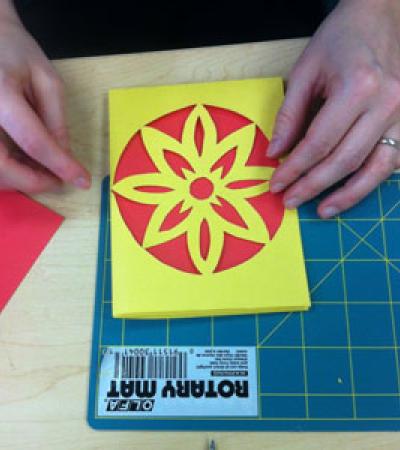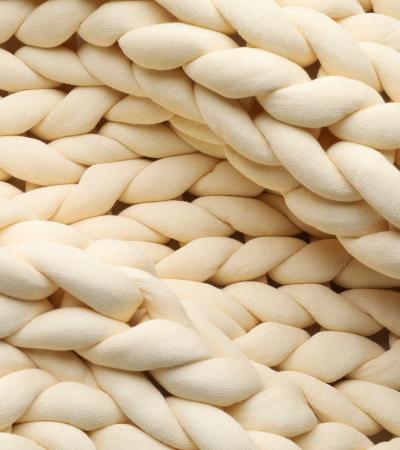The Sheep to Sweater Series featured five different programs surrounding fiber arts and the process of making wool yarn.
We began our series by touring a sheep farm and learning about raising sheep, the production of wool, shearing, fleece, treatment, spinning and roving wool. The next class was led by a heritage life skills teacher who showed us how to use a drop spindle to spin roving wool into yarn. We then learned how to hand dye wool yarn using acid dyes and yarn purchased from our local yarn store. Participants also learned how to use a yarn ball winder and a swift, which is equipment available in our Learning Lab.
Finally, we finished with a class on how to knit taught by the local yarn store owner and a class on how to crochet with a volunteer who runs a local arts organization.
Advanced Planning
This program took place throughout the month of March 2022. I wanted the series to begin where wool yarn begins, and that is with sheep. Finding a willing sheep farm was the most difficult part of the process. I took advantage of local connections in the community, such as the local yarn store owner, and I told her my idea. She put me in touch with the owner of Windy Wool Windings, who sells her yarn at the local farmer's market. This was also how I found the crochet teacher.
The yarn store owner was happy to teach the knitting class herself since she offers knitting at her store. The drop spindle spinning teacher has taught other classes at our library and offers several heritage life skills classes. I taught the hand-dyeing wool yarn class myself, so I had to research how to successfully dye wool yarn.
Marketing
We market our programs through our Facebook page, website, newsletter, on local radio stations and in the local paper. We designed the graphics for each program in the series so they had a very similar branding and were easily identifiable as part of a series.
Budgeting
Most of this series was fairly cost-effective, but a couple of the programs were more expensive than others. For example, Hand Dyeing Wool Yarn was more expensive because we purchased raw (undyed) wool yarn from our local yarn store. We found our local yarn store to be more cost-effective than a larger wool supplier. You could reduce the cost by purchasing yarn mini skeins (87 yards) instead of full skeins (277 yards). I decided that I would prefer participants to be able to take their yarn home and make something of substance that required more yarn than a mini skein.
We also had to purchase the acid dyes and squirt bottles, but both were relatively cheap and come with enough dye to host several dyeing programs, even a dye party. Some of our presenters were volunteers, such as the crochet teacher and the sheep farmer. The drop spindle spinning teacher has a set rate for her classes, but she supplied the spindles and the roving wool. We also paid a small fee to the yarn store owner.
Day-of-event Activity
Set-up for all five of our programs varied. I was the only library staff member in attendance for all programs.
Field Trip to Windy Wool Windings: Set-up for this program included contacting participants with detailed directions to the farm and instructing them where to park. I arrived early to help with parking. The program was small with a limit of 20 participants, and many of them carpooled together. This program lasted about one hour. One unexpected challenge was that there were no restrooms available for patrons to use. Luckily, this was a short enough program that it was not an issue.
Drop Spindle Spinning: For this program, I set up the room prior to the program and greeted patrons as they arrived. Participants watched a demonstration and then practiced on their own and could keep the wool they spun. Everyone sat in a circle to chat and learn together. I especially enjoyed this teacher, as she spent the class talking about different drop spindles in cultures across the world. She also talked about how a yarn item would be pulled apart and re-woven into something else instead of thrown away because of how long it took to create the yarn.
Hand Dyeing Wool Yarn: This program required the most intensive set up. First, I laid down tarps under all of the tables and reusable vinyl tableclothes on top of the tables. This was to protect the tables and carpet in our meeting room from staining. I had to pre-soak the wool yarn for 30 minutes in a water and white vinegar solution. I also had to pre-mix the acid dyes into a strong solution, which I kept in mason jars, and then dilute those into squirt bottles for patrons to use. I ordered five colors and created two bottles of each color. I set up each patron with one pre-soaked skein of yarn, two rubber gloves, and laid down layers of plastic wrap underneath and a plastic shopping bag. The plastic wrap and bag were used to transport their wet yarn home and heat-treat their yarn in a microwave. Patrons shared the squirt bottles with different colors of dye. One unexpected challenge was having to refill the squirt bottles as patrons emptied one out, but it did not take long because we have a sink in our meeting room. I would definitely recommend access to a sink for this program.
Beginner's Knitting: I only needed to set up the room for this program and greet patrons. The local yarn store owner clearly had a lot of experience teaching beginners to knit, and the class went very smoothly.
Beginner's Crochet: Similar to our knitting class, I only had to set up the room for this program. Our volunteer was also a great teacher, and the class went great.
Program Execution
My goal was to create the opportunity for an in-depth understanding of the production of wool yarn. As with many goods, technology has removed us from the harvesting and creation of yarn. For centuries, people have depended on wool and wool clothing to survive, especially in cold climates, and it was not as easy to get as stopping at a craft store. I think the sheep farm tour, drop spindle spinning, and yarn dyeing class really drove home how much work goes into creating yarn.
I found that my participants loved learning about each step in the process and the hands-on aspect to learn the skills themselves. Every single program was full with a waiting list and we brought in a lot of new patrons who have become repeat program attendees.
When I planned this series, my intention was to support local businesses and fiber artists as much as possible. I found that we definitely established new community partnerships, especially with the local yarn store. We were also able to promote the sheep farmer and her stall at the farmer's market. Additionally, the crochet teacher is eager to return and teach more classes at the library, and we are working on planning another crochet class as a series.
Advice
In the future, I would try to find a way to double some of the programs. Teaching these skills can be an intensive process, so we had to limit most of our class sizes to 10 people. By offering two sessions, you could incorporate more patrons. I would also like to add more variety of classes such as weaving, using a loom, and using a spinning wheel. Some of the classes, like crochet, would have worked better as a two-part series.
Also, having more demonstration-based classes and less hands-on classes could be more cost-effective and allow for a higher number of participants.
I would also want to spread this series out for more than just one month. Since all of the programs happened in March, it was difficult to add more programs. It would be easier to double up and add more to this series if it was spread out through multiple months or an entire season.
If you wanted to design a series like this one, I would recommend finding something you or your patrons are really interested in and starting at the very beginning. I asked myself, what is the root of all wool yarn? The sheep! So I started my program planning from that point. Then I looked into each step in the process and broke those steps down into separate programs.



